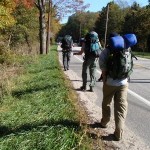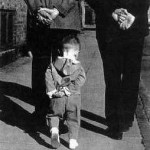The Gospel of the Gospels
Jonathan at “Jon’s Journey” has written a very good post called “Did Jesus preach the gospel?” The post is part of a series that he has been written looking at the good news in the Gospels (Matthew, Mark, Luke, and John).
He begins with the gospel as it is commonly proclaimed today: “You are a sinner. God is holy and cannot have sin in his presence. Jesus paid the debt for your sins. Trust Jesus and you will have eternal life.” (By the way, this is the gospel that I’ve heard since I was very young.)
Next, Jonathan compares this to the gospel (good news) that he finds in the Gospels of Matthew, Mark, Luke, and John. At one point, he says:
You can not read the gospels without noticing how often the topic of the kingdom of God or kingdom of heaven is on the lips of Jesus. Matt 4:23, Matt 9:35, Matt 24:14, Luke 4:43, Luke 16:16 are a few that link the word ‘gospel’ with this kingdom message. We also find his disciples were sent out preaching the same message (Matt 10:5-8, Luke 9:1-2, Luke 10:9) . We have 4 books call the ‘gospels’ that have a lot to say about the good news message Jesus and His disciples preached. Paul and the other New Testament writers continued with the same message and themes.
I think that Jonathan is making a very good point. I think the gospel includes forgiveness of sin and eternal life. But, I do not think that is the whole gospel. I’m glad that more and more people are beginning to include the good news of the kingdom in their understanding of and proclamation of the gospel.
What do you think?
Running the Race as an Illustration in Scripture – Part 3
In the first post in this series, I explained that while running recently I was reminded of several passages related to running a race and athletes. Since I started running for exercise a few months ago, I decided to look into those passages a little more closely to see if my experiences helped me to understand them.
In this post, I’m going to look at another illustration used by Paul; this one was written in his letter to the Philippians. Here is the verse in the broader context:
Therefore, my beloved, as you have always obeyed, so now, not only as in my presence but much more in my absence, work out your own salvation with fear and trembling, for it is God who works in you, both to will and to work for his good pleasure. Do all things without grumbling or questioning, that you may be blameless and innocent, children of God without blemish in the midst of a crooked and twisted generation, among whom you shine as lights in the world, holding fast to the word of life, so that in the day of Christ I may be proud that I did not run in vain or labor in vain. (Philippians 2:12-16 ESV)
This passage follows a very strong passage in which Paul instructs his readers to seek unity and fellowship by considering others as more important than themselves (Philippians 2:1-4). Paul points them to the living example of Jesus Christ, who, while being much more than an example, was a perfect example of the humility that all of God’s children should demonstrate (Philippians 2:5-11).
In this passage, Paul continues exhorting his readers by reminding the Philippians that while they are working hard at living the kind of life exemplified by Jesus Christ, God is at work in them to bring it to fruition. Thus, this passage is about maturity in Christ.
And, that is a very important difference between this passage and the ones in Galatians. In fact, almost the exact same phrase is used in Galatians 2:2 and Philippians 2:16, that is, “running in vain.” However, the illustration of running a race in vain (a race that cannot be completed) is used to illustrate two very different points in Galatians and Philippians.
Remember that in Galatians, Paul compared trusting in righteousness by keeping the law to running in vain. But, in Philippians, Paul compares failure to live by “holding fast to the word of life” to running in vain. In this passage, he says that a child of God who fails to mature is like running a race that cannot be finished. Interestingly, Paul sees this maturity as partly his responsibility.
We can see this double responsibility (proclaiming the gospel of grace and helping others mature in grace) in Paul’s letters and in his activities as recorded by Luke in the Book of Acts. Thus, for Paul, failure to trust completely in God and the righteousness that he bestows by his grace is like running in vain. But, at the same time, failure to continue growing in maturity in Jesus Christ is also like running in vain. The two go together.
What would you like to add to this discussion?
——————————
Running the Race as an Illustration in Scripture:
1) Part 1 – 1 Corinthians 9:24-27
2) Part 2 – Galatians 2:2 and Galatians 5:7
3) Part 3 – Philippians 2:16
4) Part 4 – Hebrews 12:1
5) Part 5 – 2 Timothy 2:5
Organic life within traditional church structures?
I was greatly encouraged when I read a post by Trey (from “Practical Christianity – Living God’s Way“) called “Non-Comformity within Traditional Church.”
In the post, he writes about a group of believers who meet as part of a traditional church. But, according to Trey, the group demonstrates a living and active community in Christ.
He writes:
Within the context of a largely traditional Southern Baptist church, I witnessed an outside-the-box, passionate ministry of believers that simply did not follow the “script”. No Sunday School quarterlies were passed around. The teacher did not read from the teacher’s guide verbatim. The participants of this class were not grouped according to age. No lesson was taught in the traditional sense. What did happen looked surprisingly like the New Testament. A group of believers ages 20-60, united and changed by the power of Christ in the Gospel, were engaging with one another with the goal of growth and edification. Challenges were made to one another about walking daily with Christ. Prayers were prayed spontaneously. New believers were asking lots of questions. Every member ministers were commissioned for service in other areas within the church. These folks loved this traditional church yet were free to express themselves within the context of their small group community.
Like I said, I’m greatly encouraged to read about this kind of life in Christ within a traditional church. (This is one of the things that I wrote about in my post “Why I’m not a house church proponent.”)
My hope and prayer is that others would see this group living in community in Christ and seek the same kind of fellowship with other brothers and sisters in Christ. I also hope that the leaders of the traditional church organization would be willing to make any necessary modifications so that this kind of growth would no longer be seen as “outside-the-box,” but would become normal. Finally, I hope that all brothers and sisters in Christ would welcome and encourage this kind of growth and community, regardless of our thoughts concerning traditional, institutional, organic, simple, or any other adjectival church…
(By the way, don’t miss another great post by Trey called “Contentment is key.”)
Running the Race as an Illustration in Scripture – Part 2
In a previous post in this series, I explained that while running recently I was reminded of several passages related to running a race and athletes. Since I started running as exercise a few months ago, I decided to look into those passages a little more closely to see if my experiences helped me to understand them.
In this post, I’m going to look at two short illustrations in Paul’s letter to the believers in the cities of the region of Galatia. Here is the first passage:
I went up because of a revelation and set before them (though privately before those who seemed influential) the gospel that I proclaim among the Gentiles, in order to make sure I was not running or had not run in vain. (Galatians 2:2 ESV)
Before this passage, Paul had explained that he did not receive his gospel through human intermediaries, but instead received it directly from God. (Galatians 1:15-17) But, Paul did go up to Jerusalem later to meet with the apostles in order to compare what he understood about the good news of Jesus Christ with the gospel that the apostles were proclaiming.
In this illustration, Paul is concerned that the two gospels (his and the apostles’) might be different (i.e., one might be a gospel of grace while the other a gospel of works). He says that if he was proclaiming a different gospel than the one that the apostles had heard from Jesus, then it would be like running a race in vain – that is, a race that could not be won or could not be completed.
For the second passage, I’m going to include the wider context:
For freedom Christ has set us free; stand firm therefore, and do not submit again to a yoke of slavery. Look: I, Paul, say to you that if you accept circumcision, Christ will be of no advantage to you. I testify again to every man who accepts circumcision that he is obligated to keep the whole law. You are severed from Christ, you who would be justified by the law; you have fallen away from grace. For through the Spirit, by faith, we ourselves eagerly wait for the hope of righteousness. For in Christ Jesus neither circumcision nor uncircumcision counts for anything, but only faith working through love. You were running well. Who hindered you from obeying the truth? This persuasion is not from him who calls you. A little leaven leavens the whole lump. I have confidence in the Lord that you will take no other view than mine, and the one who is troubling you will bear the penalty, whoever he is. (Galatians 5:1-10 ESV)
There was a time when the Galatians were living according to the gospel of righteousness by grace; but, lately, and apparently through the false teaching of one or more people, some of them were turning back toward righteousness by keeping the law.
He compares following these false teachers to being hindered during a race, which would make the false teachers and the false gospel the hindrances or obstacles.
In both of these examples from Galatians, living according to a false gospel (a gospel that teaches righteousness by works instead of righteousness by the grace of God through faith in him) is like running a race in vain (one that cannot be finished) or running a race filled with obstacles.
Imagine for a moment running a race that has no course and no finish line. Imagine a race that is never finished – never complete. That is the illustration that Paul uses for a life lived by the righteousness of keeping the law.
Imagine a race where every path is blocked by obstacles – every turn leads to a dead end. That is the illustration that Paul uses for a life lived by the righteousness of doing good deeds.
Both of these types of races are impossible to run. In the same way, it is impossible to live in such a way as to be righteous by keeping the law or by doing good works.
——————————
Running the Race as an Illustration in Scripture:
1) Part 1 – 1 Corinthians 9:24-27
2) Part 2 – Galatians 2:2 and Galatians 5:7
3) Part 3 – Philippians 2:16
4) Part 4 – Hebrews 12:1
5) Part 5 – 2 Timothy 2:5
The Church in America from a British Perspective
A couple of months ago, I published a guest post by Peter who is from the UK. That post was called “House Churches: British Experiences to Teach the USA.” I really appreciated Peter’s post because it is always valuable to read other people’s perspectives, especially those who are outside the current situation or context.
Arthur at “The Voice of One Crying Out in Suburbia” has now published another guest post from someone else in the UK. His guest blogger is Christopher, and the post is called “The American Church – From the Outside Looking In – An English Perspective.”
While Peter’s post (that I published) primarily focused on house or organic church, Christopher’s post (that Arthur published) focuses on several different aspects of the American church. He calls them Charismaniacs, the Religious Right, the Reformed, the Emerging Church, and Organic/Simple Church Movement.
Once again, I enjoyed reading Christoper’s perspective on the church in America (just as I enjoyed reading Peter’s earlier perspective). I think that we (as Christians in America) can learn considerably by listening to those outside our borders, especially other brothers and sisters in Christ.
What are you thoughts about Christoper’s post?
Running the Race as an Illustration in Scripture – Part 1
If you’ve been reading my blog over the last few months, then you know that I began walking in July for exercise. After a couple of weeks of walking, I started running, short distances at first, then eventually running longer distances. (In fact, yesterday I ran the longest distance I’ve run yet: 7.5 miles.)
One day, as I was running, some different passage of Scripture came to mind in which the authors used running or races or athletes as illustrations or examples. I decided to looking more closely into these passages in order to determine if my recent experiences with running could help me understand them.
Here is one those passages:
Do you not know that in a race all the runners compete, but only one receives the prize? So run that you may obtain it. Every athlete exercises self-control in all things. They do it to receive a perishable wreath, but we an imperishable. So I do not run aimlessly; I do not box as one beating the air. But I discipline my body and keep it under control, lest after preaching to others I myself should be disqualified. (1 Corinthians 9:24-27 ESV)
Just before this passage, in 1 Corinthians 9:19-23, Paul had expressed how he gladly gave up his rights for the sake of the gospel. Though free from the law (by the grace of God), he would become as one under the law (a Jew who had not received the gospel) for the sake of sharing the gospel with the Jews. To Gentiles – those who were not under the law – Paul would live as one outside the law so that he could better share the gospel with Gentiles. He would give up everything for the weak or the strong for the sake of the gospel.
Then, Paul gave the illustration above about the the runner (and boxer). The focus of the passage is not on the one who receives the prize (as if living in Christ is a competition with other believers). Instead, the focus is on giving up what is rightfully your for the sake of the gospel in the same way that an athlete gladly and willingly gives up certain foods or activities for the sake of winning that prize.
Back in July, the doctor gave me a sheet that described a diet called the Mediterranean Diet. It’s not so much a way to reduce calories as it is a new way to approach food. So, according to this diet, I should only eat 1-2 servings of red meat each week, plus 1-2 servings of fish (particularly fish high in Omega-3 fatty acids), and several servings of poultry. Most importantly, I should be very careful of the serving sizes, keeping them in the range of 3-5 ounces depending on the type of meat.
Also, according to the diet, I should eat several servings of vegetables (6-8) and fruit (3-4) each day. Plus, I need to make sure that I’m eating true vegetables and not starches such as potatoes and corn or beans and legumes. I can eat those things, but they should not count as vegetables.
Now, I’m free to eat any food that I want. But, if I want my body to be healthier – especially if I want to be able to run longer and longer distances at faster paces – then I must be extremely careful about what I eat. In other words, I must discipline my body and keep it under control.
Paul says that he takes the same approach to the gospel. While he is free to do many things, he gives up those rights for the sake of the gospel (just like an athlete gives up certain foods and activities for the sake of excelling in the sport).
This illustration helps Paul explain what he had already written to the Corinthians concerning “weak” brothers and sisters in chapter 8. He had also used himself as an example in the first part of chapter 9 where he explained to his readers why he refused to take money and instead worked to support himself and those who traveled with him.
In the same way that I’m learning to control what I eat and how I exercise in order to be able to run, I also need to learn to control my desires, my wants, my rights even in order to share the gospel with those around me and helping them mature in Christ.
What would you like to add to this?
——————————
Running the Race as an Illustration in Scripture:
1) Part 1 – 1 Corinthians 9:24-27
2) Part 2 – Galatians 2:2 and Galatians 5:7
3) Part 3 – Philippians 2:16
4) Part 4 – Hebrews 12:1
5) Part 5 – 2 Timothy 2:5
Scripture… As We Live It #178
This is the 178th passage in “Scripture… As We Live It.”
(This passage was given to my by my friend Lew.)
And Jesus said to them, “Whose likeness and inscription is this [coin]?” They said, “Caesar’s.” Then he said to them, “Therefore render to Caesar the things that are Caesar’s, and to God the things that are God’s after giving 10% to your local church, and churches organized as 501(c)(3) charitable organizations should pay nothing to Caesar.” (Matthew 22:20-21 re-mix)
(Please read the first post for an explanation of this series.)
Replay: Lessons from the Appalachian Trail
Three years ago – and it’s hard to believe that it has been three years – I joined my son, Jeremy, and a friend of mine and his son on a three day hike on part of the Appalachian Trail in Pennsylvania. When we returned home, I wrote about several “lessons learned” in a blog series. (The first post was called “Lessons from the Trail 1 – Introduction.”) The introductory post is below, as well as links to the other posts. I really enjoyed our time on the trail, in spite of the problems that I encountered. I hope I’m able to do something like this again soon.
————————————–
Lessons from the Trail 1 – Introduction
From Thursday, October 9, through Saturday, October 11, my son, Jeremy, and I joined my friend, Jim, and his son, Jason, on a hiking and camping trip through a very small portion (21 miles) of the Appalachian Trail in Pennsylvania. If you are not familiar with the Appalachian Trail, it winds its way through the Appalachian Mountains for over 2100 miles from Maine to Georgia. We started in Pennsylvania where the trail ran near the home of Jim’s father, who dropped us off at our starting point, picked us up at our destination, and offered wonderful hospitality before and after our trip.
Our hike started in Pine Grove Furnace State Park and ended just over 21 trail miles and just over 50 hours later in picturesque Boiling Springs, PA. During the hike, we saw many beautiful sites, almost ran out of water, battled very sore muscles, and learned alot about ourselves. In fact, this series is not going to be about the hike, per se. I am not going to share my trip diary, although I did keep one. Instead, I want to share some “life lessons” that I learned on this trip.
Now, I recognize that 21 miles is not a long way to hike for many people. In fact, we passed some hikers who were walking the entire length of the AT over several months. One man who passed us was running our route in less than one day. However, for two 40 (+) year old men and two teenage boys, it was a long hike.
I was surprised at how much I learned about life during this hike. Some of these lessons I learned through my own quiet meditation (well, mostly quiet… there was some grunting and groaning) during the hike. Other lessons I learned while talking with Jim or the boys. It seemed like every turn in the trail, every ascent or descent, every rocky ridge, every ache and pain offered more lessons, if I was willing to learn. I tried to learn. Perhaps you can help me.
As I share these various life lessons, I encourage you to help me and others learn about life together. Perhaps you have a story to share; then please share it. Perhaps you have another perspective; then share that. Please use my hiking and camping trip as an opportunity to “exhort one another”.
(By the way, if you’re interested, I’ve posted pictures from our trip in a Facebook album.)
————————————–
Lessons from the Trail Series:
1. Introduction
2. Preparation
3. Watching
4. Burdens
5. Leaders
Another blogger’s thoughts on teaching and doctrine
This morning, I published a post about terms related to teaching in the New Testament. (See my post “New Testament Terms Related to Teaching.”) I was happy to find that another blogger that I respect greatly has come to some of the same conclusions as me concerning teaching.
Bobby at “Deconstructing Neverland” expressed some of these views in his post “Barking up the wrong tree.”
His post primarily revolves around considering this question: “What is most beneficial in helping someone mature as a follower of Jesus Christ?” He concludes that what is typically called “doctrinal teaching” is not very helpful at helping a brother or sister mature in Christ… yes, even good doctrinal teaching.
Here is a small part of Bobby’s excellent post:
Maturity comes through experiencing the Life of Christ in us as we walk in the Spirit not through endless preaching and teaching of historical creeds and confessions. If we want to mature we must have relationships with others who are more mature than us and imitate their way of life. If we want to help others mature we must walk through life with them and live a life worth imitating. But first we gotta stop barking up the wrong tree and decide instead to hike our leg on it and move on.
But, in fact, what Bobby talks about IS what Scripture calls “doctrine.” The idea that teaching/doctrine is speaking or lecturing about Scripture is not found in the New Testament. Certainly, this type of activity can be part of teaching, but it is a small part. Teaching in the New Testament is primarily one of observation (i.e., watching how another believer lives) and imitation (i.e., living in a similar manner).
The fact that the church has replaced demonstration/observation/imitation with lecture is one of the reasons (I think) that so many believers remain immature today.
So, read the remainder of Bobby’s post, and comment there. Then, tell us here what you think about his post and my response above.
New Testament Terms Related to Teaching
I’m putting together a workshop (or series of lessons) on the subject of teaching in the New Testament. I hope to lead our church through this study sometime early next year, perhaps in January. I’m excited to discover new things about this topic, both from my own study and from the church as we guide each other through the Scriptures.
To begin the study, I thought I would put together a list of terms found in the New Testament related to teaching. I’m not saying that these terms are synonymous (although they sometimes seem to be used that way). However, I think that if we want to understand teaching from the New Testament perspective, we also need to understand these related terms.
While each of these terms is a translation/gloss of a Greek word, I do not plan to list the Greek terms. If you have any question about which Greek term I’m using, feel free to ask in the comments. However, I will list a few relevant passages in which the term is used.
Teach/Instruct (verb)
The primary verb primarily denoting some type of instruction which includes both verbal and nonverbal communication. (Acts 20:20, Colossians 3:16, 1 John 2:27)
Teacher (noun)
The person who is carrying out the instruction. (1 Corinthians 12:20, Hebrews 5:12, James 3:1)
Teaching/Instructing/Instruction/Lesson/Doctrine (noun)
The activity or process or content of teaching or instructing. (Acts 2:42, 1 Corinthians 14:6, 2 John 1:10) (There are two different Greek terms that have a similar range of meanings.)
Admonish/Warn/Instruct (verb)
A form of instruction that seems to be related to possible problems ahead. (Acts 20:31, Romans 15:14, 1 Thessalonians 5:12, 1 Thessalonians 5:14)
Rebuke (verb)
A form of instruction related to pointing out existing problems. (2 Timothy 3:16, see also Psalm 38:12)
Correct (verb)
A form of instruction related to both pointing out and also changing problems. (2 Timothy 3:16)
Encourage/Exhort/Implore/Urge (verb)
Help (both verbal and nonverbal) to move in a certain direction (depending on the context, could be spiritually, emotionally, mentally, intellectually, etc.). (Colossians 2:1-2, Hebrews 10:24-25, 1 Peter 5:12)
Encouragement/Exhortation (noun)
The content or process of helping someone moving in a certain direction. (Acts 15:31, 1 Corinthians 14:3, Hebrews 12:5)
Edify/Build Up/Strengthen (verb)
To make someone stronger (depending on the context, could be spiritually, emotionally, mentally, intellectually, etc.). (Acts 9:31, 1 Corinthians 14:4, 1 Thessalonians 5:11)
Edification (noun)
The content or process of making someone stronger. (Romans 15:2, 1 Corinthians 14:26, Ephesians 4:12)
Disciple (verb)
To help someone be a follower. (Matthew 28:19-20, Acts 14:21)
I’m also thinking about including the terms “proclaim/preach/announce” and “evangelize/preach/proclaim the good news.” Do you think there are other important terms to consider when studying teaching in the New Testament?








